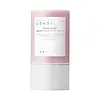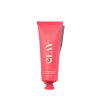What's inside
What's inside
 Key Ingredients
Key Ingredients

 Benefits
Benefits

 Concerns
Concerns

 Ingredients Side-by-side
Ingredients Side-by-side

Water
Skin ConditioningKaolin 8%
AbrasiveDipropylene Glycol
HumectantGlycerin
HumectantCI 77891
Cosmetic ColorantButylene Glycol
HumectantSodium Stearate
CleansingCentella Asiatica Extract 4.9%
Cleansing1,2-Hexanediol
Skin ConditioningPhaseolus Angularis Seed Powder
Aloe Barbadensis Leaf Extract
EmollientCetearyl Olivate
Propanediol
SolventSorbitan Olivate
EmulsifyingDimethicone
EmollientCI 77491
Cosmetic ColorantEthylhexylglycerin
Skin ConditioningSodium Phytate
Bentonite
AbsorbentIllite
AbrasiveMineral Salts
Skin ConditioningMontmorillonite
AbsorbentCalamine
AbsorbentWater, Kaolin 8%, Dipropylene Glycol, Glycerin, CI 77891, Butylene Glycol, Sodium Stearate, Centella Asiatica Extract 4.9%, 1,2-Hexanediol, Phaseolus Angularis Seed Powder, Aloe Barbadensis Leaf Extract, Cetearyl Olivate, Propanediol, Sorbitan Olivate, Dimethicone, CI 77491, Ethylhexylglycerin, Sodium Phytate, Bentonite, Illite, Mineral Salts, Montmorillonite, Calamine
Water
Skin ConditioningCetrimonium Chloride
AntimicrobialGlycerin
HumectantCellulose
AbsorbentCetyl Lactate
EmollientVanillin
MaskingPhenoxyethanol
PreservativeEthylhexylglycerin
Skin ConditioningCamellia Sinensis Leaf Extract
AntimicrobialAnanas Sativus Fruit Extract
Skin ConditioningLactobacillus/Papaya Fruit Ferment Extract
AbrasiveBetaine
HumectantAcrylates Copolymer
Sodium Hydroxide
BufferingSalicylic Acid
MaskingCI 19140
Cosmetic ColorantCI 42090
Cosmetic Colorant
 Reviews
Reviews

Ingredients Explained
These ingredients are found in both products.
Ingredients higher up in an ingredient list are typically present in a larger amount.
Ethylhexylglycerin (we can't pronounce this either) is commonly used as a preservative and skin softener. It is derived from glyceryl.
You might see Ethylhexylglycerin often paired with other preservatives such as phenoxyethanol. Ethylhexylglycerin has been found to increase the effectiveness of these other preservatives.
Glycerin is already naturally found in your skin. It helps moisturize and protect your skin.
A study from 2016 found glycerin to be more effective as a humectant than AHAs and hyaluronic acid.
As a humectant, it helps the skin stay hydrated by pulling moisture to your skin. The low molecular weight of glycerin allows it to pull moisture into the deeper layers of your skin.
Hydrated skin improves your skin barrier; Your skin barrier helps protect against irritants and bacteria.
Glycerin has also been found to have antimicrobial and antiviral properties. Due to these properties, glycerin is often used in wound and burn treatments.
In cosmetics, glycerin is usually derived from plants such as soybean or palm. However, it can also be sourced from animals, such as tallow or animal fat.
This ingredient is organic, colorless, odorless, and non-toxic.
Glycerin is the name for this ingredient in American English. British English uses Glycerol/Glycerine.
Learn more about GlycerinWater. It's the most common cosmetic ingredient of all. You'll usually see it at the top of ingredient lists, meaning that it makes up the largest part of the product.
So why is it so popular? Water most often acts as a solvent - this means that it helps dissolve other ingredients into the formulation.
You'll also recognize water as that liquid we all need to stay alive. If you see this, drink a glass of water. Stay hydrated!
Learn more about Water